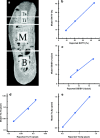A network modeling approach for the spatial distribution and structure of bone mineral content
- PMID: 24671611
- PMCID: PMC4012050
- DOI: 10.1208/s12248-014-9585-8
A network modeling approach for the spatial distribution and structure of bone mineral content
Abstract
This study aims to develop a spatial model of bone for quantitative assessments of bone mineral density and microarchitecture. A spatially structured network model for bone microarchitecture was systematically investigated. Bone mineral-forming foci were distributed radially according to the cumulative normal distribution, and Voronoi tessellation was used to obtain edges representing bone mineral lattice. Methods to simulate X-ray images were developed. The network model recapitulated key features of real bone and contained spongy interior regions resembling trabecular bone that transitioned seamlessly to densely mineralized, compact cortical bone-like microarchitecture. Model-simulated imaging profiles were similar to patients' X-ray images. The morphometric metrics were concordant with microcomputed tomography results for real bone. Simulations comparing normal and diseased bone of 20-30 to 70-80 year-olds demonstrated the method's effectiveness for modeling osteoporosis. The novel spatial model may be useful for pharmacodynamic simulations of bone drugs and for modeling imaging data in clinical trials.
Figures






References
-
- Foundation IO. Facts and statistics: International Osteoporosis Foundation 2013. http://www.iofbonehealth.org/facts-statistics-category-14.
-
- Kanis JA. Assessment of osteoporosis at the primary health care level: report of a WHO Scientific Group. Sheffield, UK: World Health Organization; 2007.
Publication types
MeSH terms
LinkOut - more resources
Full Text Sources
Other Literature Sources
Medical

